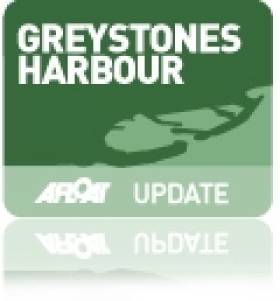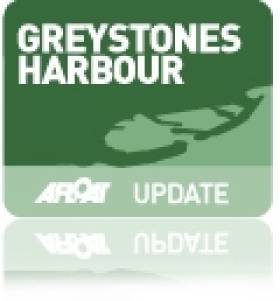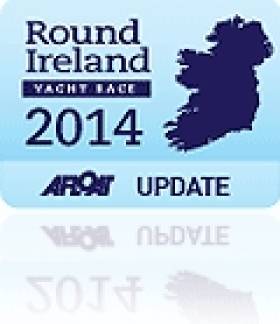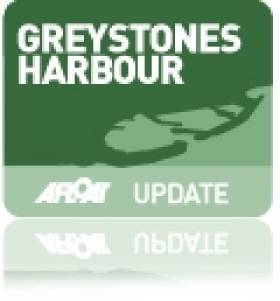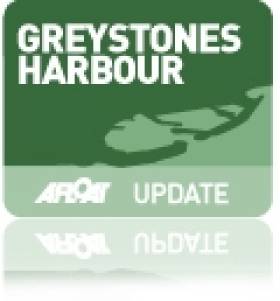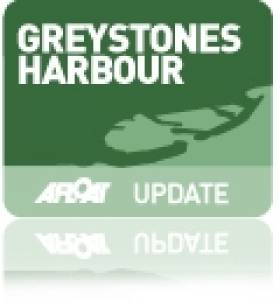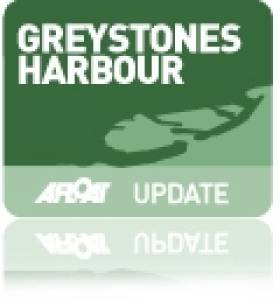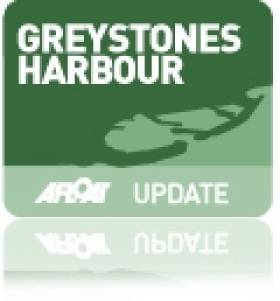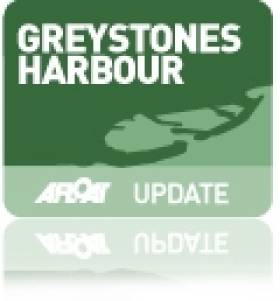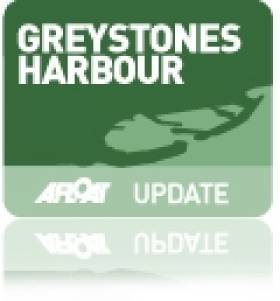Displaying items by tag: Greystones Marina
#greystonesharbour – Greystones Sailing Club's annual "Taste of Greystones" Cruiser Regatta will take place on Sunday 31st August. The inaugural event last year attracted 72 cruisers registered with 68 actually racing. This year organiser Joe Taylor hopes to make it even bigger
The entry fee of €50 includes your overnight berth and of course the much talked about BJ Marine Greystones Harbour Marina lunch and refreshments. Also included are various vouchers for the Club bar and for the Beach House.
Hot breakfasts will be available on site Sunday morning followed by two races starting at 10.45. Racing should be completed by about 14.30 and followed by that lunch and the prizegiving. The big bonus is everybody will be home by tea time, says Taylor.
Feeder races on the Saturday for those who would like to race down will have their prizeging in the Greystones Sailing Club clubhouse around 19.30.
More details downloadable below
Greystones Harbour Marina Welcomes Round the World Yachts on Eve of Round Ireland Race
#greystones – Ireland's newest marina at Greystones harbour has welcomed in two Round Ireland race competitors for Saturday's nearby race start from Wicklow harbour. As previously reported on Afloat.ie the new 200–berth marina will be home to a chartered Volvo 70 Monster and a Farr 60 until shortly before Saturday's 2pm start. 35 boats are entered for the Wicklow Sailing Club biennial race that can take up to one week to complete. Greystones Marina manager Alan Corr told Afloat.ie he is delighted to be able to offer convenient deep water berths for the high tech visitors.
#RoundIreland - When Wicklow farmer David Ryan found the 70-foot racer he's entering in the Round Ireland Yacht Race was too big to berth at the county town's harbour, he was in a bit of a pickle.
But that was until the new Greystones Marina stepped in to help, as the Wicklow Voice reported on 29 May.
The marina's manager Alan Corr has hailed its hosting of Ryan's Volvo 70 class Monster Project as "great news for Greystones. We're trying to put the marina on the sailing map and this can only help."
As previously reported on Afloat.ie, Monster Project will set out with the rest of the Round Ireland racing fleet on 28 June aiming to be first to cross the line in Wicklow.
Greystones Harbour Lecture at National Yacht Club Highlights New East Coast Boating Facility
#greystonesharbour – Last Wednesday night (28th August) in The National Yacht Club, an audience of up to sixty people heard of the origins, design and construction of the new Greystones Harbour, presented by Councillor Derek Mitchell of Wicklow County Council and Sean Mason of Arups.
The event was hosted by the Civil Division of Engineers Ireland in response to a request from members of the DBSC Thursday night racing community who couldn't make the original presentation at the Clyde Road offices of Engineers Ireland.
Councillor Mitchell gave some of the historical and political background to the project and touched on some of the community aspects while Sean Mason dealt with the technical aspects of the design and construction.
The lecture started at 19:35 and finished after 21:00 with the speakers taking up just over an hour. An active Q&A session followed the presentation.
The development of the harbour is a first for the PPP model of investment whereby a combination of public and private investment funds the project. Representatives of the contractor, Sisks, were in the audience and they too contributed to some of the answers that were provided.
The Civil Division would like to thank our hosts for the evening, The National Yacht Club, the speakers, Messrs Mitchell & Mason, the people who came out to listen to the lecture, Afloat magazine and the four Dun Laoghaire yacht clubs who promoted the lecture.
Cormac Bradley
Chairman, Civil Division
Engineers Ireland.
Greystones Marina Packs in a Fleet of 70 for First Ever Cruiser Regatta
#greystonesharbourmarina – With 68 entrants and a host of visiting boats, the inaugural Greystones Harbour cruiser regatta made a wonderful spectacle for Greystones Sailing Club and the newly opened Greystones Harbour marina when it was staged yesterday in sunny weather off the Wicklow coast.
The new marina which has 100 berths swelled to capacity at the weekend with up to 150 boats berthed.
The successful staging and significant numbers involved for the one day event has already piqued interest from neighbouring clubs who say they are now considering feeder races for a similar 2014 regatta. It's a spirit of co-operation between east coast clubs that might yet see the return of the south–east coast regatta.
Current ECHO handicapping arrangements have proved to be a deterrent for inter–club racing on the east coast and although Greystones Cruiser organiser Dara Cafferkey admits staging the event under standard ECHO handicap was 'a challenge' yesterday, he hopes local hospitality and a lot of shoreside fun in Greystones more than made up for any technical shortcomings.
Yesterday's fixture and the novelty of a complimentary berth in Ireland's newest marina attracted 11 boats from Poolbeg Yacht and Boat Club. Bray Sailing Club sent seven racers and Wicklow eight. Four yachts travelled across the bay from Howth Yacht Club with the balance of the visiting fleet came from the large racing fleet on nearby Dublin Bay, including six Ruffians and seven Sigma 33s.
Greystones local Graham Noonan sailing Flash (a modified Formula 28') was the Class one winner with Dublin Bay's First 44.7 Lively Lady (Rodney Martin) second. Third was the Royal Irish YC club–mate Indecision, a J1209 skippered by Declan Hayes.
In Class 2 results as follows: 1 Hydrogen Jason Morne , 2 Astrix Fraser Meredith and 3 Great knots Paul Sunderland.
In White sails: 1 Tiger Stephen Harris, 2 Warrior David Shanahan and 3 Spellbound Graeme Burrow. The Poolbeg feeder was won by Seagual Roger Smith. 2. Dragon fly Alo McGoldrick
Afloat.ie readers may recall Class one winner Flash arrived in Dun Laoghaire from Liverpool for the 2011 Volvo regatta when it was involved in a collision with a Sigma 33' causing major structural damage. Graham Noonan in his role as a boatbuilder with Noonan boats rebuilt her and modified the boat to bring it back to winning form. Flash scored a second in the 2013 Volvo regatta and is currently club racing in Wicklow Sailing Club, also home to Hydrogen yesterday's winner of class 2.
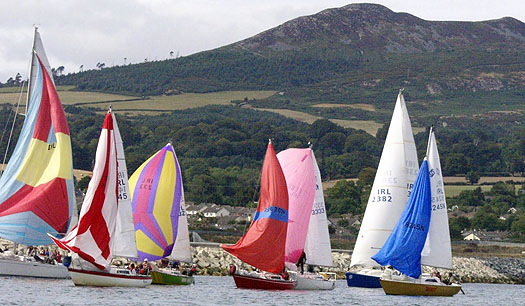
The Wicklow mountains make an attractive backdrop for the first ever Greystones cruiser regatta held yesterday. Photo: Alan Jones
Although the offshore conditions were very shifty, the festival atmosphere ashore more than made up for any vagaries in the wind with generous hospitality before and after the two race event. On Saturday evening Greystones Sailing Club staged a pre-event BBQ while BJ Marinas Ltd, the operators of the town marina, provided a prize giving spread of food and drink after racing.
The new town marina opened at Easter and some of the first boats to arrive was a cruise in company from Howth. Since then news of the new marina has spread culminating in yesterday's big fleet.
As Afloat.ie reported in March, Greystones Sailing Club was quick to identify the new opportunity presented by the marina and now it looks set to be an annual fixture.
First Keelboat Regatta for Greystones Harbour Marina
#greystonesharbourmarina – In a first for the dinghy club in Wicklow, Greystones Sailing Club and the newly opened Greystones Harbour Marina has made moves to introduce keelboat racing to the area this season and has announced the inaugural Greystones Cruiser Regatta for September 1.
The new town marina opened at Easter and some of the first boats to arrive was a cruise in company from Howth.
As Afloat.ie reported in March, the club was quick to identify the new opportunity presented by the marina.
A marina berth on the Saturday for the keelboat regatta is included as part of the entry fee.
The regatta will include:
Sailing club reception on Saturday evening
Marina reception post-racing on Sunday
Early prize giving at 3.30pm
3 classes including white sails
Early entry encouraged to ensure a berth.
Race Notice and Entry Form are available to download below or from www.gsc.ie or Text/Call Daragh on 087 2580215
Greystones Harbour & Marina Hosts its First Gathering Cruise
Less than four weeks after opening its initial batch of pontoon berths, Greystones Marina has hosted its first gathering of cruisers with the Cruising Association of Ireland mustering at the new harbour over the weekend of April 27/28 writes WM Nixon.
The severe weather of the Spring of 2013 has delayed many fitting-out programmes, but so keen were CAI members to celebrate the new facility that those whose boats weren't ready joined their Commodore John Leahy at the venue by road.
He was among those who'd sailed down from Dublin Bay with his Moody 33 Eblana to enjoy glorious if cold sunshine on the Saturday, and a fine fair wind off the land to speed them home on Sunday.
The Beach House was the natural venue for the shoreside conviviality, and numbers using Greystones – both as marina residents, and as visitors – will steadily increase as the season gets going.
The Gathering Cruise will call by in July, while the Irish Cruising Club Eastern Region are planning their first major fleet movement to the re-born North Wicklow harbour in late August.
But historically speaking, they'll all be following the Eblana, which is now indisputably in the records as the first leader of the first cruising group to visit Greystones.
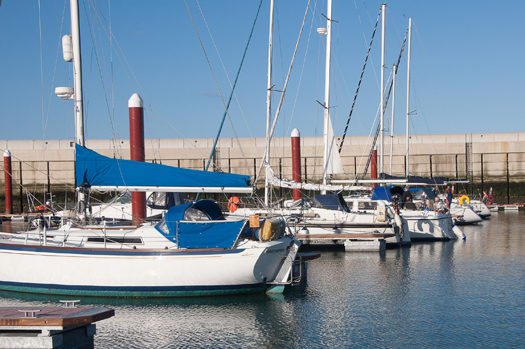
The new marina in Greystones is starting to attract an eclectic fleet of resident boats. Photo: Aidan Coughlan
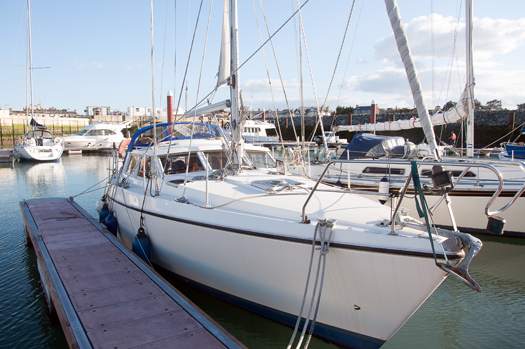
The flagship of the first fleet to Greystones – John Leahy's Moody 33DS Eblana brings the sunshine to North Wicklow. Photo: Aidan Coughlan
#greystonesharbour – With work at Greystones Harbour marina progressing well this month, piling nearly complete and pontoons being floated into position, Greystones Sailing Club has been putting together a provisional programme for Keelboat racing this season.
In an exciting new era for the Club its keelboat captain Mark Usher has invited all keelboat berth holders, and those who intend to apply for a berth, to an open discussion in the Club on Friday 22nd March at 8pm when outline plans for the season ahead will be announced.
Greystones Harbour Marina Rates & Application Form Here!
#greystonesmarina – Greystones Harbour and Marina in County Wicklow announced its berthing rates today two months ahead of its scheduled opening for the 2013 boating season. An application form has alos been published. You can download the rates and application form below as pdf documents below.
The much anticipated rates are as follows: An annual berth licence is €375 per metre. A six month (April to September) berth licence is €275 per metre. A 'casual' one month licence is also on offer at €60 per metre.
Daily visitor rates are also published at €3.50 per metre
The terms say that a 20% deposit is required to secure berth with the balance due before April 1 2013
The 100-berth marina has confirmed it will be open from the 1st April, 2013.
Operators BJ Marinas Ltd say they have received over 100 berth enquiries to date and are looking forward to a busy first season.
#greystones – Sisk builders announced yesterday that it has agreed with its partners Park Developments and their bankers NAMA that Sisk will take ownership and control of the County Wicklow project. Originally developed in partnership, the substantial structure of the breakwaters and harbour has been completed and part opened to the public recently. The land side of the development has stalled with the financial crisis and with NAMA's involvement. Slipways are in place but long awaited marina furniture has yet to be installed in the new harbour.
'I am very pleased that Sisk have taken control as they are financially very stable, have been around for a century, take a long term view and are knowledgeable on marine affairs. NAMA are a bureaucratic organisation not suited to moving this imaginative project forward' Greystones Councillor and sailor Derek Mitchell said last night.
Parts of the harbour are now open including the best public boat launching facilities in Ireland (2 public slipways reaching to below low water) and compounds have been given to 5 Community organisations (Sea Scouts, Rowers, Sailors, Divers and Anglers). The South Breakwater and the car park are also open. Already this is one of the best water sport facilities in Ireland. The uncompleted area towards Bray Head is currently being grassed and it is hoped to open the marina in 2013. The latter is held up by threatened legal action over a commercial matter.
The Project is a public private partnership between Sispar and Wicklow County Council which when completed will consist of a new harbour, a marina, public areas including landscaped park and public square, a new primary care centre, retail space, club houses and boat storage, public slipways, a dedicated coastguard slipway, a site for a coastguard building and high quality residential development.
The company has recently carried out a series of works to improve public access to and enjoyment of the harbour area. This includes providing public access to the south breakwater; extensive launch facilities for use by the coastguard, clubs and sailing community; green amenity areas; and car park space.
The hoardings around the harbour area and on the North Beach Road have been removed and palisade fencing along a large section of the cliff walk has been replaced with more attractive fencing in order to enhance the appearance of the walk. Sispar have recently commenced grassing over the site area thus fully responding to the community's concerns over the appearance of the site.
"We have invested close to €75million in the Project so far and are totally committed to seeing it through" said a spokesperson for Sispar, "the economics of the development have been significantly affected by the economic downturn. However, the major harbour works are completed and there is now public access to the harbour. The remainder of the project can progress once critical decisions on funding and planning are taken and there is a recovery in the Irish economy".
NAMA, the SISK Group and Park Developments have reached an agreement which will result in the SISK Group acquiring Park's interest in the project and the taking on full responsibility for the Project. One outcome of this agreement is that there will no longer be any debt owed to NAMA by Sispar in relation to the project. Sispar is continuing to work with Wicklow County Council on delivery of the project on a phased basis.
Sispar is also currently engaging with all relevant stakeholders to the Project in order to finalise issues arising out of this agreement.


























